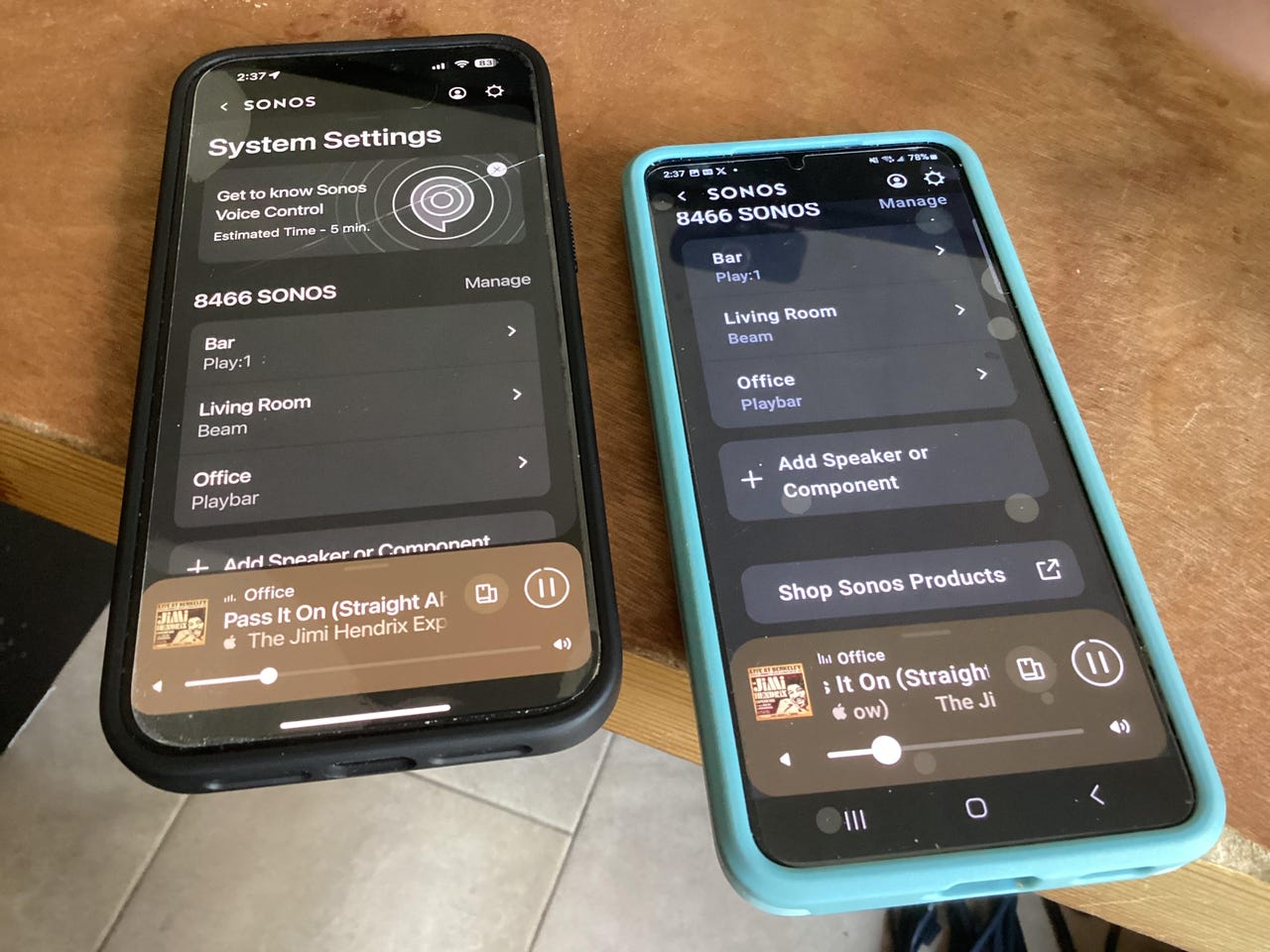
Sonos S2 controller shown on iPhone (left) and Android (right).
Jason Perlow/ZDNET
Companies in the consumer electronics industry are always looking for ways to incorporate the latest technology into their products and, by extension, our daily lives. Sonos, a major player in the multi-room audio market, recently updated its S2 controller app for iOS, iPadOS, and Android.
Also: The best Sonos speakers: How the Sonos One, Arc, Beam, and more compare
The new version features a unified and streamlined user interface experience. Additionally, Sonos has introduced a web-based user experience for Mac and Windows desktop platforms, accessible through www.sonos.com/web-app. This new interface replaces the old desktop controller — the company no longer appears to be distributing the desktop version.
While this move towards a more integrated software environment is exciting, it does raise questions about the future of hardware upgrades and the lifespan of existing devices.
Observations of the new S2 UX
The new Sonos S2 controller app for iPadOS.
Screenshot by Jason Perlow/ZDNET
The new user experience (UX) of Sonos’s iOS, Android, and iPadOS apps is consistent and visually appealing. The design is modern and streamlined, with a focus on accessibility and readability. The web version, which has replaced the desktop version, also follows this approach, indicating a strategic alignment in Sonos’ software development.
Although I did not explore the web UX extensively, I did test its functionality for finding and playing music in different rooms. The web UX appears to be designed to reflect the settings of the smartphone UX and, as such, is strictly a content player. Configuring and changing the settings of a Sonos system or its components now requires the smartphone app, as none of these tasks can be completed through the browser.
It is uncertain whether the codebase is entirely unified. The missing configuration options in the web user interface indicate that the smartphone versions may require extra local software components to execute that specific function. Here’s what is evident: What is evident: For the web control to function, the components now have significantly more cloud connectivity than they did before.
Nevertheless, the consistent visual appearance across all platforms does significantly enhance the user experience.
The harmonious: advantages of Sonos’ web-based platform
The new Sonos S2 web controller, as shown on a Mac.
Screenshot by Jason Perlow/ZDNET
The primary advantage of Sonos’ new software strategy lies in its apparent commitment to uniformity. By developing a single, cohesive web-based platform, Sonos ensures that all users, regardless of the device they use, experience the same interface and features. This consistency eliminates the fragmentation often seen in apps developed separately for different platforms and aligns perfectly with the contemporary consumer’s expectation for seamless integration.
Also: One of the most premium Chromebooks I’ve tested is cheaper than you’d think
The updated software sports a cleaner design and boasts enhanced functionality, such as improved search capabilities, making it easier for users to find their favorite music and podcasts. This focus on usability can significantly enhance user satisfaction and cement Sonos’s reputation as a user-centric brand.
The dissonant: the challenge of hardware compatibility
Moving to a web-based platform might not be without its challenges. This approach indicates a potential shift from prioritizing hardware to prioritizing software, which might result in slower hardware innovation or force older models to become obsolete if they cannot support newer software updates.
Also: These speakers deliver impressively accurate sound for any style of music
In the past, Sonos has faced criticism for transitioning between major software versions, such as the move from S1 to S2, which left some older devices unable to integrate with newer systems. This segmentation of the ecosystem can be frustrating for users who have invested heavily in their audio setups only to find them somewhat outdated due to software incompatibilities.
While the list of S2-compatible hardware has not changed with the controller and recent firmware updates to support it, the changeover to this now cloud-connected version raises a few eyebrows.
The bigger picture: software over hardware?
A view of the Sonos S2 controller on iPhone.
Screenshot by Jason Perlow/ZDNET
The consumer electronics industry is shifting towards a software-dominated approach, where device functionality and durability depend more on software updates than hardware capabilities. This shift could redefine consumer expectations and force a reevaluation of what it means to “upgrade.”
Also: The best over-ear headphones: Expert tested and reviewed
Instead of buying new hardware, consumers might want to consider how long their current devices will remain compatible with new software releases. How consumers respond to these changes can significantly impact brand loyalty.
Companies like Sonos that balance innovation with support for legacy systems are likely to retain loyal customers. Being transparent about product lifecycles and offering programs to help customers upgrade older, incompatible devices could alleviate dissatisfaction.
Looking forward: the role of innovation in user experience
Sonos’ latest move toward a software-centric approach reflects a broader trend in the consumer electronics industry. While this shift has the potential to offer an enhanced user experience, companies need to be mindful of how it affects consumer trust and satisfaction. As Sonos navigates this new terrain, its success will depend on how well it integrates its software innovation with hardware compatibility.
Also: The most immersive speaker system I’ve ever tested is not from Bose or Sonos
Although Sonos’ new software platform simplifies audio control, it raises questions about the future of hardware upgrades and overall system compatibility. Sonos’ ability to manage these challenges will determine whether its software strategy resonates with consumers or falls short.




















